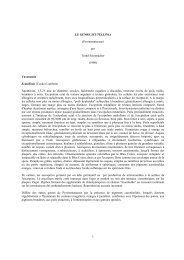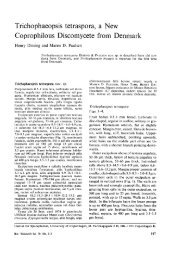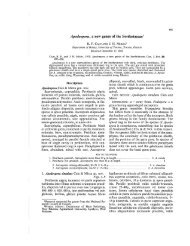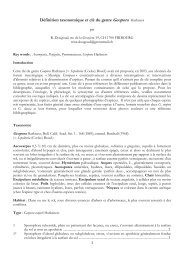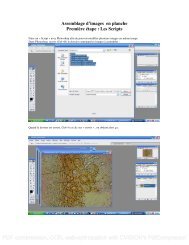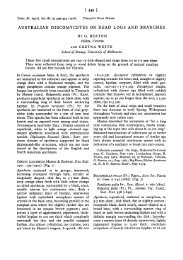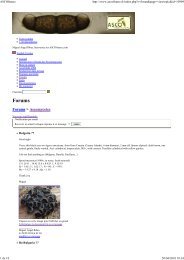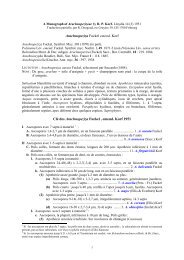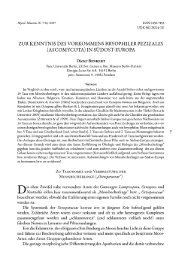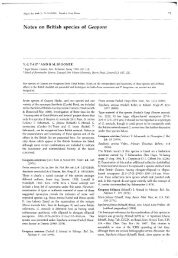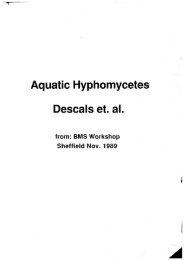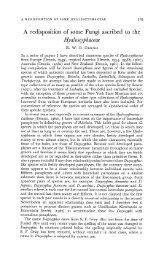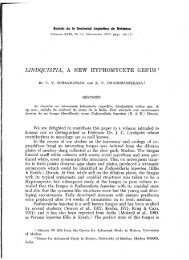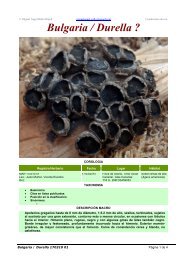Stray Studies in the Coronophorales (Pyrenomycetes) 4-8 - ASCOfrance
Stray Studies in the Coronophorales (Pyrenomycetes) 4-8 - ASCOfrance
Stray Studies in the Coronophorales (Pyrenomycetes) 4-8 - ASCOfrance
Create successful ePaper yourself
Turn your PDF publications into a flip-book with our unique Google optimized e-Paper software.
322 J. A. Nannfeldtlike <strong>the</strong> Nitschkiaceae, have Lasiosphaeriaceous ancestors and so it is still justifiedto treat it <strong>in</strong> this paper.Prof. Santesson has contributed <strong>the</strong> follow<strong>in</strong>g descriptions and comments: —"Sometimes very small but characteristic ascocarps of a fungus appear on <strong>the</strong>discs of dead, black apo<strong>the</strong>cia of certa<strong>in</strong> species of Sticta. At first, this fungus wastaken for a new species of Acanthonitschkea. The cupulately collaps<strong>in</strong>g ascocarpsarmed with rigid, sharp-po<strong>in</strong>ted sp<strong>in</strong>es, <strong>the</strong> clavate asci taper<strong>in</strong>g to a th<strong>in</strong> stalk, <strong>the</strong>absence of paraphyses, and <strong>the</strong> small fusiform to ellipsoidal, hyal<strong>in</strong>e spores seemedto <strong>in</strong>dicate a relationship to this o<strong>the</strong>rwise corticolous genus. This suggesion couldnot be upheld. The fungus was found to take a ra<strong>the</strong>r isolated position and has to beplaced <strong>in</strong> a new genus.Nitschkiopsis Nannf. & R. Sant. nov. gen.Peri<strong>the</strong>cia sicca cupulato-collapsa, papilla apicali dist<strong>in</strong>cta. Peridium membranaceum,fuscescens. Asci 8-spori, clavati, stipitati, annulo apicali <strong>in</strong>crassato. Sporae fusiformes velellipsoideae, 1-septatae, hyal<strong>in</strong>ae.—Lichenicola.Typus: N. stictarumNannf. & R. Sant.N. stictarum Nannf. & R. Sant. nov. sp.Peri<strong>the</strong>cia madefacta ± globosa, 0.09-0.12 mm diam., fusco-nigricantes, pilis hyal<strong>in</strong>is et sp<strong>in</strong>isfuscis ornata. Sporae 6-7x 1.5-2 /xm.—In apo<strong>the</strong>ciis Stictarum.Typus: Kenya, Santesson 22144 f (holotypus: UPS; isotypus: S).The vegetative dark mycelium immersed <strong>in</strong> <strong>the</strong> ± dead tissues of <strong>the</strong> host.Peri<strong>the</strong>cia at first immersed <strong>in</strong> <strong>the</strong> necrotic hymenia of <strong>the</strong> host but later superficial, scatteredor sparsely gregarious, when moist almost spheric with a slightly protrud<strong>in</strong>g conical papilla,which is somewhat paler than <strong>the</strong> rest of <strong>the</strong> peri<strong>the</strong>cium, when dry collapsed <strong>in</strong>to cup-shapewithout any visible papilla. The upper part of <strong>the</strong> peri<strong>the</strong>cium furnished with sp<strong>in</strong>es and hairs.Sp<strong>in</strong>es 1-celled, thick-walled, dark brown to almost black, 12-20 /xm long, ± conical withpo<strong>in</strong>ted apex and up to 3-5 /xm broad, basally ra<strong>the</strong>r abruptly enlarged to 6-12 /xm. Hairs2-5-celled, th<strong>in</strong>-walled, hyal<strong>in</strong>e, subcyl<strong>in</strong>drical, 55-85 (xm long and mostly 3.5—1 /xm broad,apically rounded and <strong>the</strong> apical as well as <strong>the</strong> basal part slightly enlarged, ca. 5 /¿m and 5-6 /xmrespectively. The dark sp<strong>in</strong>es usually 10-25 per peri<strong>the</strong>cium, <strong>the</strong> hyal<strong>in</strong>e hairs much fewer,usually 3-6 only. Hyal<strong>in</strong>e hairs rarely with dark brown zones and a flattened broad base, thus <strong>in</strong>some respects transitional to dark sp<strong>in</strong>es.Peridium membranaceous, pseudoparenchymous, <strong>in</strong> th<strong>in</strong> sections ra<strong>the</strong>r pale brown, 10-15/xm thick, <strong>the</strong> paler papilla ca. 25-30 /xm <strong>in</strong> diam.Asci 8-sporous, 30-40x5-6 /xm, clavate, ra<strong>the</strong>r long-stalked, non-amyloid; apical r<strong>in</strong>g dist<strong>in</strong>ct,thickened. No paraphyses visible. Below <strong>the</strong> papilla a cushion (ca. 15-20 /xm) ofperiphysis-like hyphae.Fig. 5. Nitschkiopsis stictarum (holotypus). (a-c, e) Hairs and sp<strong>in</strong>es on <strong>the</strong> surface of <strong>the</strong> ascocarps. (a, c)Hyal<strong>in</strong>e hairs with rounded tips and slightly thickened bases, (e) Dark-brown sp<strong>in</strong>es with po<strong>in</strong>ted tips andbroad flattened bases. (b) Transitional types with dark parts on <strong>the</strong> hyal<strong>in</strong>e hairs and broad flattened bases(ca. 700x). — (d,f) Median sections of ascocarps, (d) show<strong>in</strong>g <strong>the</strong> prom<strong>in</strong>ent ostiolarpart (seen also <strong>in</strong> a),f show<strong>in</strong>g <strong>the</strong> arrangement of <strong>the</strong> asci and <strong>the</strong> periphysis-like hyphae (ca. 500x).Svensk Bot. Tidskr. 69 (1975)



